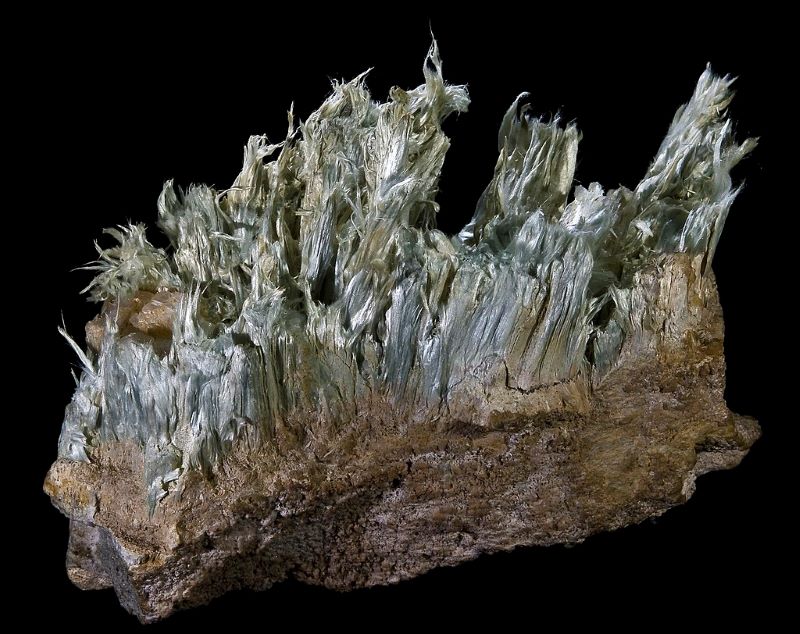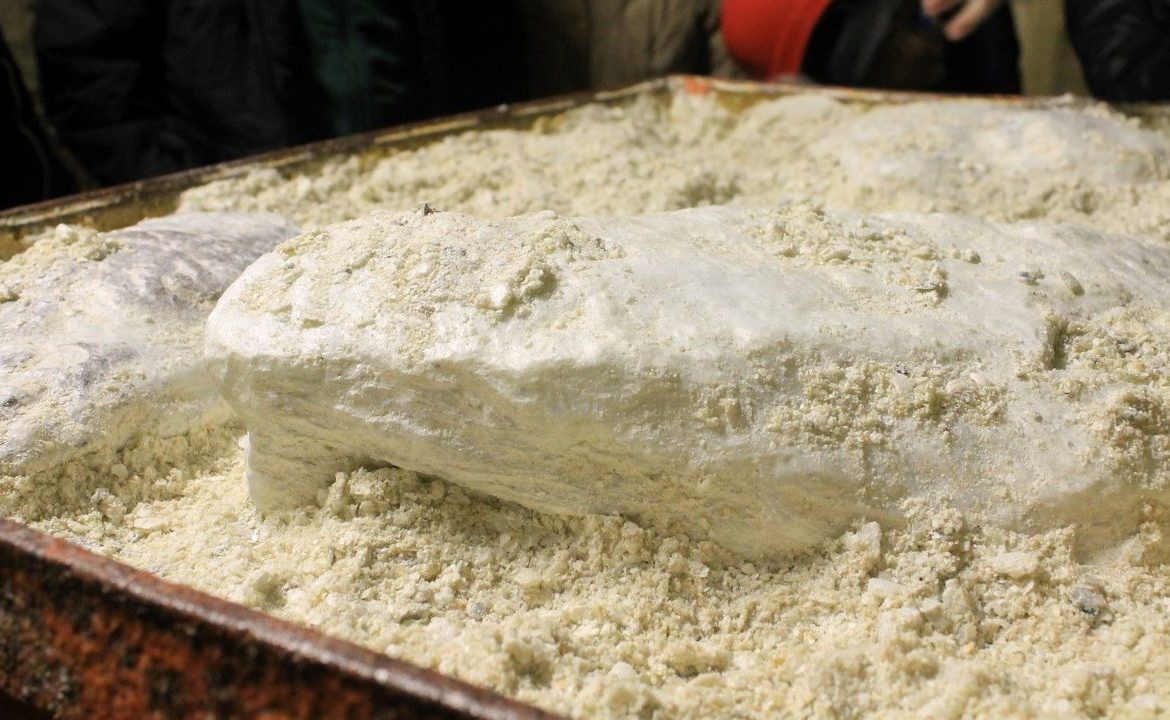Talc is a fascinating mineral that has had many uses for many years. However, these days, any time talc is in the news, it’s because Johnson & Johnson is being sued by ovarian cancer patients over its talcum powder. And, given that an awful lot of us used talcum powder on our babies, this is scary news indeed. I mean, I used talcum powder, on my daughters when they were babies… Which means that I’m very keen to known whether talcum powder can cause cancer.
Unfortunately, and is so often the case: it’s complicated!
For a start, the International Agency for the Research on Cancer (IARC) has three distinct categories for Talc:
- Talc containing asbestiform fibres (See asbestos) – Group 1: carcinogenic to humans
- Talc not containing asbestos or asbestiform fibres – Group 3: Not classifiable as to its carcinogenicity to humans (not a carcinogen)
- Talc-based body powder (perineal use of) – Group 2B: Possibly carcinogenic to humans
These classifications are for the mineral, Talc, and not the product, ‘Talcum Powder’. This is because Talc is not just used to make talcum powder. Talc is also used in an astonishing number of industries and products due to its properties as a lubricant. And the simple fact that Talc, which we think of as a powder, is used for lubrication means that I need to understand more about this stuff.
Talc, as it turns out, is a rock. A very soft rock, admittedly, but a rock nonetheless. In fact Talc is the softest rock in the World, with a value of 1 on the Mohs Scale of mineral hardness. Diamond is at the other end of the scale, with its value of 10. Graphite, the ‘Lead’ you get in pencils, has a Mohs value of 1.5. Real Lead, the metal, has the same Mohs value as Graphite, but is also incredibly poisonous, which is why it is no longer used in pencils.
The reason that I mention Graphite is that it’s basically made of lots of hexagonal scales, pressed together. When you draw a pencil along a piece of paper, it leaves a track of these scales, which is the line that you see. If you have a sticky zipper, you can scrape the tip of a pencil along the teeth and the zip will run smoothly again. This is because the graphite scales are lubricating the zip. Talc, on the other hand, is made of octagonal scales. These scales are even smaller and softer than their graphite cousins. All of which is why Talc is such a widely used dry lubricant.
The talcum powder that we know and (used to) love is a mixture of finely ground Talc and corn starch. Sometimes a perfuming agent is added to the mix. Either way, the resulting ‘talcum powder’ can then be used as an astringent to offset nappy (diaper) rash and/or to keep areas dry. However, because talcum powder is so fine, it very easily becomes airborne. And airborne talcum powder, in high enough concentrations, can lead to breathing difficulties. Which is why it is now recommended that parents use zinc-oxide ointments on nappy rash, and not talcum powder.
To give an idea what level of airborne Talc is considered a risk, we must turn to industry:
In the United States, the Occupational Safety and Health Administration and National Institute for Occupational Safety and Health have set occupational exposure limits to respirable talc dusts at 2 mg/m3 over an eight-hour workday. At levels of 1000 mg/m3, inhalation of talc is considered immediately dangerous to life and health. [Source]
Learning that 1g of Talc in a cubic meter of air is ‘immediately dangerous to life and health’ makes me glad I don’t use the stuff. In reality, though, talcum powder is mixed with corn starch and an incredibly low percentage of what you shake out gets airborne. As such the amount of actual Talc that you’ll be breathing in from talcum powder is unlikely to be that high. Even so, it’s a risk that I’m willing and able to completely avoid.

Photo by Daniel Lincoln on Unsplash
And the risk isn’t from cancer, it’s from your lungs getting clogged up by the dust in the air. Although experiments have been done to see if cosmetic grade Talc (talcum powder) can cause cancer in rats. Said rats were exposed to Talc for 30 hours a week for four months straight. So, yeah, of course some of these rats got cancer! I’m only surprised that they survived long enough to do so.
Which is why the IARC concluded that airborne Talc does not pose a cancer risk…
Unless it’s got asbestos in, then it definitely poses a cancer risk. Not from the Talc, but from the asbestos contaminating it.
The problem is that asbestos and Talc are formed under the same sort of conditions. They also have very similar chemical makeups…
Ah, I said to myself that I wouldn’t do this, but what the Hell:
- Talc looks like this: Mg3 Si4 O10 (OH)2
- Serpentine Asbestos is: Mg3 Si2 O5 (OH)4
- Tremolite Asbestos has: Ca2 Mg5 Si8 O22 (OH)2
They all have Magnesium (Mg), Silicon (Si), Oxygen (O) and hydroxy groups (OH), just in slightly differing amounts. The Tremolite asbestos also has some calcium (Ca) chucked in. And it’s the Tremolite that is the most dangerous of the common asbestos contaminants of Talc. You really don’t want to be breathing that stuff in!
You don’t have to be a chemist to see that these three minerals are pretty closely related, chemically speaking. And I only mention any of this to help make sense of why asbestos was so often found in Talc. Asbestos and Talc are formed in similar ways, under similar conditions. Talc and Serpentine asbestos, in particular, are both sheet silicates. So, if you find one, you’ll probably find the other. You start digging one out on an industrial scale, some of the other is going to get caught up.
All that said, the problem of Talc being contaminated with asbestos was pretty much dealt with in the 1970s. For example, in the USA:
In 1973, the FDA developed new standards stating talc should be tested to ensure it is asbestos-free talc. The law remains in place today. However, the FDA does not currently require testing of talc cosmetics for asbestos before they are added to store shelves. Once a product is on the market, the FDA monitors for safety. [source]
Arrangements like this do occasionally result in health scares involving products containing Talc. Like in 2015, when asbestos was found in crayons. Specifically, the Talc between the crayon and its paper covering. But the reality is that finding asbestos in talcum powder, or any other Talc-containing product, is extremely unlikely. For more information about the risks of asbestos, see here.
So, now that asbestos is no longer found in Talc, and breathing it in can’t cause you cancer, is talcum powder completely safe?

By Didier Descouens – Own work, CC BY-SA 4.0, https://commons.wikimedia.org/w/index.php?curid=8725525
Well, if you’re a man, yes.
If you’re a woman, the jury is still out…
There is a persistent and ongoing association between ovarian cancer and talcum powder use in the perineal area. This association seems to have started with some research in 1971, which found particles of Talc embedded in 75% of the ovarian tumors studied. Another study in 2008 found that regular users of talcum powder were at a 36% increased risk of ovarian cancer. Cancer Research UK responded to this study and concluded:
All in all, there is some suggestion from existing studies that talcum powder is associated with a higher risk of ovarian cancer but the evidence isn’t very strong. It is possible that any links are due to statistical blips, or that there is something else that talc users have in common that could affect their risk of ovarian cancer. Either way, there is clearly a need for more definitive research involving larger groups of people.
The ovarian cancer charity Ovacome has also responded to the question of whether talcum powder can cause cancer. In 2013 Ovacome produced, Fact Sheet 15 – Is there a link between ovarian
cancer and talcum powder? This fact sheet had the following to say:
We still do not know what really causes ovarian cancer… It is also important to remember that, out of the millions of women in England and Wales, many of whom use talc, only a very small number will develop ovarian cancer each year. So even if talc does increase the risk slightly, very few women who use talc will ever get ovarian cancer. Also, if someone has ovarian cancer and used talc, it seems unlikely that using talc was the reason they developed the cancer.
Moving to the USA, where Johnson & Johnson has been successfully sued by ovarian cancer patients and/or their families…
The American Cancer Society page on Cancer and Talcum Powder concludes:
It is not clear if consumer products containing talcum powder increase cancer risk. Studies of personal use of talcum powder have had mixed results, although there is some suggestion of a possible increase in ovarian cancer risk.
Meanwhile, the WebMD page, Can Talcum Powder Cause Cancer (which I can’t link to, because it has the same title as this post), says:
A study of more than 250,000 women between 1976 and 2017 found no significant link between women’s use of talcum powder on their genitals and ovarian cancer. Still, scientists continue to study the topic. It may be that talc raises the risk for people in certain age groups or for particular types of ovarian cancer.
Sorry to spam quotes from so many other sites but as a man writing about ovarian cancer, I don’t want to appear too opinionated.

By Darb02 – Own work, CC BY-SA 4.0, https://commons.wikimedia.org/w/index.php?curid=47624290
Having said that…
On balance, I would say that it is unlikely that talcum powder can cause ovarian cancer. Aside from all the quotes from authoritative sources, above, there is the IARC classification. The IARC has put the risk that talcum powder can cause ovarian cancer in group 2B. Which is to say that talcum powder can possibly cause ovarian cancer.
I need to give this some context…
- The IARC puts the ‘consumption of processed meat‘ as a group 1: known carcinogenic to humans.
- It has the ‘consumption of red meat’ as a group 2A: probable carcinogen.
- Meanwhile, the ‘use of talcum powder in the perineal area’ is a group 2B: possible carcinogen.
Logically speaking, if you think that using talcum powder is too much of a risk, you should be considerably more worried about eating red meat. And there’s no way you’d be seen anywhere near processed meat…
But what it really comes down to is attitude to risk. And what everyone considers to be an acceptable risk in their lives. And that is something that we all must decide for ourselves. Although, hopefully, this post might be helpful in coming to that decision.
To my mind, there is some possibility that a woman using talcum powder in her genital area could increase her risk of ovarian cancer. On the other hand, this risk can be eliminated by simply not using talcum powder for that purpose. Non Talc-based alternatives do exist.
However, if the use of talcum powder in the perineal area is that important to someone, they will probably be fine to keep doing so.
As to whether this risk is worth the reward?
That is entirely up to you.

6 thoughts on “Can Talcum Powder Cause Cancer?”
Thank you for a very informative study about talc!
I was offered a VASP surgery w hen the lung is cut and covered with a talc, to fix reoccuring pleural effusion of tge lung. I wonder how dangerous it is to leave the talc in my pleural area forever…
Hi there,
You would hope that any talc used in a hospital had been tested for asbestos. Because it is only when there is asbestos contamination that talc becomes a risk.
My thought is that the talc would have been tested for contamination and that you’re perfectly safe in this regard.
Take care,
Paul
Do you post your updates on a different site?
Hi Theresa,
Thanks for getting in touch.
I don’t post on another site. I just haven’t been able to post for quite a while due to an annoyingly persistent bout of depression…
Hopefully, I’ll be able to rectify this situation in the next few weeks.
All the best,
Paul
Hi Paul
How are you doing ?
Hope you are healthy and living life to the full ! Not seen any posts for some time .
Take care .
Hi Dan,
Thank you for your kind words.
I’ve been healthy on the cancer-front for coming up 4 years, which is an ever-increasing new record.
Unfortunately, I’ve been somewhat under the cosh with depression, hence the lack of posts. I do think I’m starting to move past that, though, so hopefully there will be some new posts soon.
All the best,
Paul